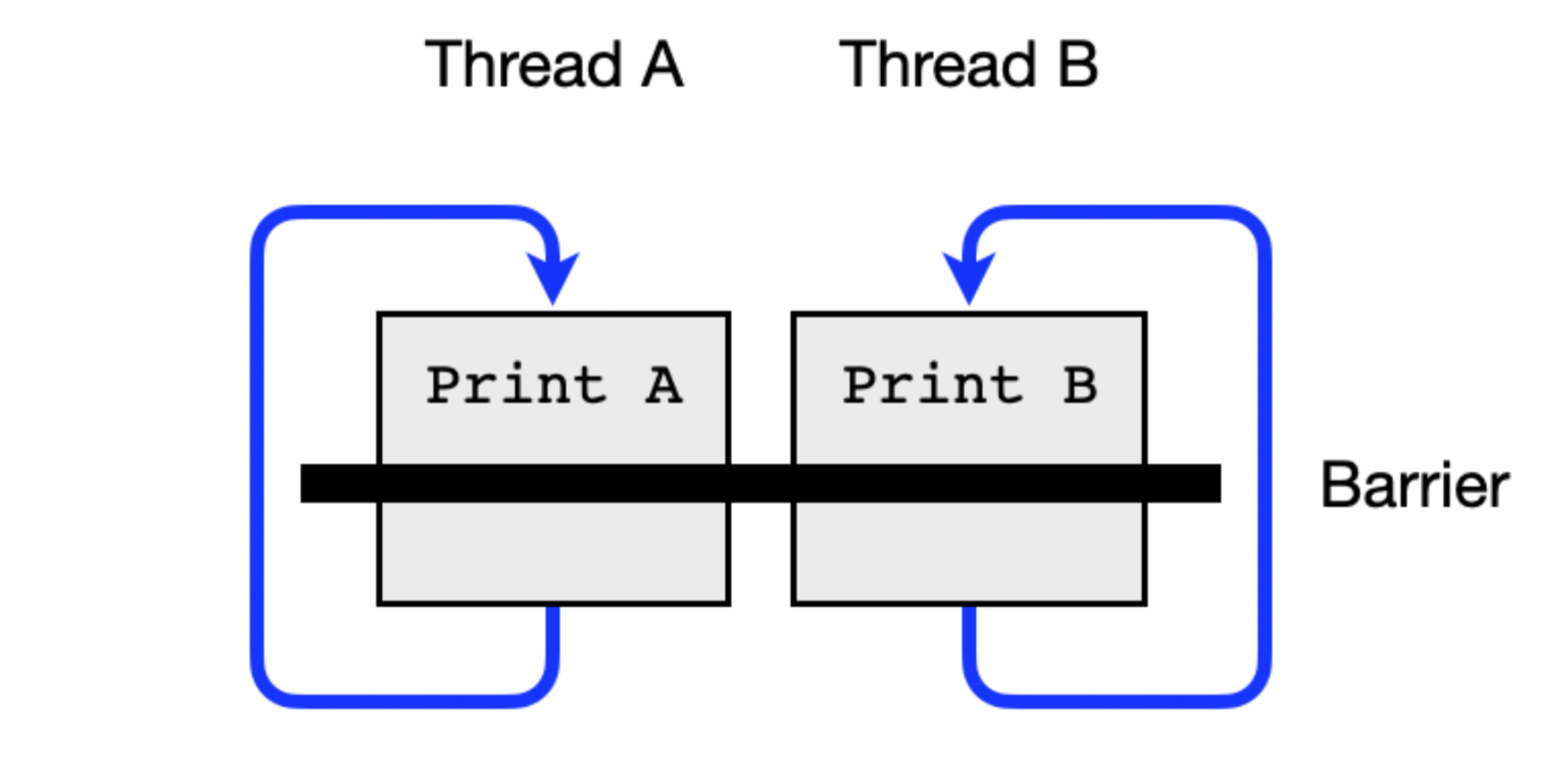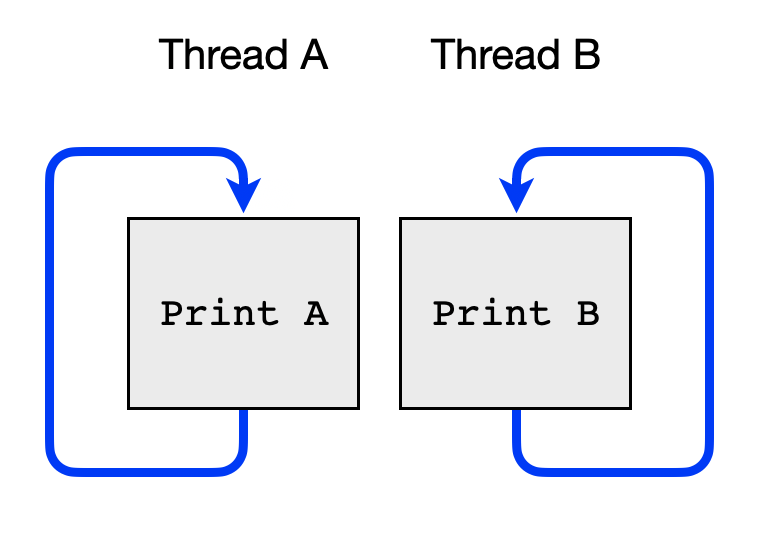Two thread barrier synchronization
Mandatory assignment
Background
A mutex lock is meant to first be taken and then released, always in that order, by each task that uses the shared resource it protects. In general, semaphores should not be used to enforce mutual exclusion. The correct use of a semaphore is to signaling from one task to another, i.e., a task either signal or wait on a semaphore, not both.
In this assignment you will solve the two thread barrier problem using semaphores. This problem clearly demonstrates the type of synchronization that can be provided by semaphores.
Supported platforms
The provided code has been developed and tested on the department Linux system and macOS. Most likely you will be able to use any reasonable modern version of Linux.
Overview
- File to use
mandatory/src/two_thread_barrier.c- Description
- In this program, a process creates two threads A and B, and waits for their termination. Each thread performs N iterations. In each iteration the threads print their name (A or B) and sleeps for some random amount of time. For each iteration the order between the threads should not be restricted.
Compile and run
In the terminal, navigate to the mandatory directory.
Use make to compile the program.
makeThe executable will be named barrier and placed in the bin sub directory.
Run the program from the terminal.
./bin/two_thread_barrierQuestions
Run the programs several times and study the source code. Think about the following questions.
- Could you predict the output before execution? Why?
- Adjust the sleeping duration of one thread (or both threads) to have a different output (ie. another interleaving of the tasks traces). Could you predict this output? Why?
Rendezvous
Rendezvous or rendez-vous (French pronunciation: [ʁɑ̃devu]) refers to a planned meeting between two or more parties at a specific time and place. 1
Barrier synchronization (desired behavior)
We now want to put in a barrier in each thread that enforces the two threads to have rendezvous at the barrier in each iteration.
For each iteration the order between the threads should not be restricted. The first thread to reach the barrier must wait for the other thread to also reach the barrier. Once both threads have reached the barrier the threads are allowed to continue with the next iteration. Examples of execution traces:
- AB BA BA AB BA (valid barrier synchronization)
- AB BB AB AA AB (invalid synchronization)
Other names for barrier synchronization are lock-step and rendezvous.
Two thread barrier implementation
Your task is to use semaphores to enforce barrier synchronization between the two threads A and B.
Before you continue think about the following questions.
- What needs to be initialized?
- What needs to be done by each thread inside the barrier?
Compile and run
Compile:
make, and run the program:
./bin/two_thread_barrierExample incorrect synchronization
This is an example of an invalid execution trace when running the two_thread_barrier program.
Two threads A and B doing 5 iterations each in lockstep.
Iteration 0
A
B
Iteration 1
B
A
Iteration 2
B
B <===== ERROR: should have been AExample of correct synchronization
This is an example of a valid execution trace when running the two_thread_barrier program.
Two threads A and B doing 5 iterations each in lockstep.
Iteration 0
A
B
Iteration 1
A
B
Iteration 2
B
A
Iteration 3
A
B
Iteration 4
A
B
SUCCESS: All iterations done in lockstep!Configuration
In the beginning of two_thread_barrier.c you find the following definitions.
#define ITERATIONS 10 // Number of iterations each thread will execute.
#define MAX_SLEEP_TIME 3 // Max sleep time (seconds) for each thread. Experiment by changing the number of iterations and the max sleep time.
- Does the output change?
- What are the possible outputs?
Portable semaphores
Use the psem semaphores to enforce rendezvous between the two threads. This is how you declare and initialize a portable psem semaphore.
psem_t *semaphore;
semaphore = psem_init(0);Number of semaphores
How many semaphores are needed to enforce barrier synchronization between two threads?
- Can this be achieved using a single semaphore?
- Do you need to use two semaphores?
- Do you need more than two semaphores?
Declare global semaphore variables
For simplicity, declare all psem_t semaphore variables globally.
Initial semaphore values
Initialize your semaphore(s) in the beginning of main(). Should the semaphore(s) be initialized with counter value:
- 0?
- 1?
- some other value?
Destroy semaphores after use
At the end of main(), don’t forget to destroy any semaphores you have initialized.
Automatic error detection
Instead of printing their identity (A or B) directly, the threads uses the provided trace function.
In each iteration thread A calls trace('A') and thread B calls trace('B').
The trace functions prints the thread identity and keeps track of the next valid thread identity
in the traced sequence. If the wrong thread identity is traced an error is reported and the process is terminated.
Code grading questions
Here are a few examples of questions that you should be able to answer, discuss and relate to the source code of you solution during the code grading.
- How are mutex locks different compared to semaphores?
- In general, what will happen when you wait on a semaphore?
- In general, What will happen when you signal on a semaphore?
- Explain the barrier synchronization concept.
- How can semaphores be used to enforce barrier synchronization between two threads?
- Why can’t mutex locks be used as drop-in replacements for the semaphores in your solution with lock instead of wait and unlock instead of signal?


